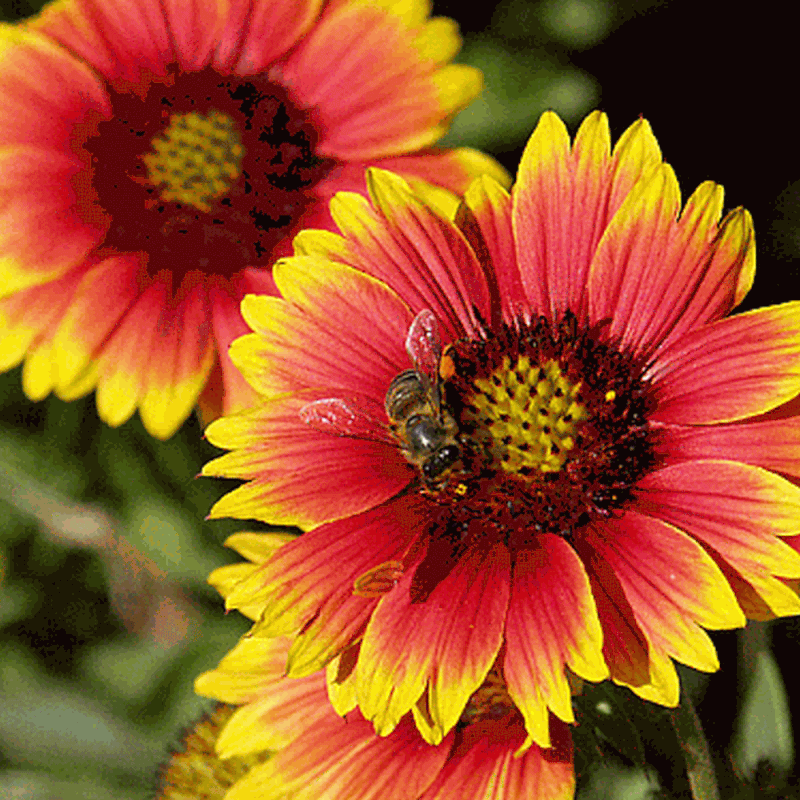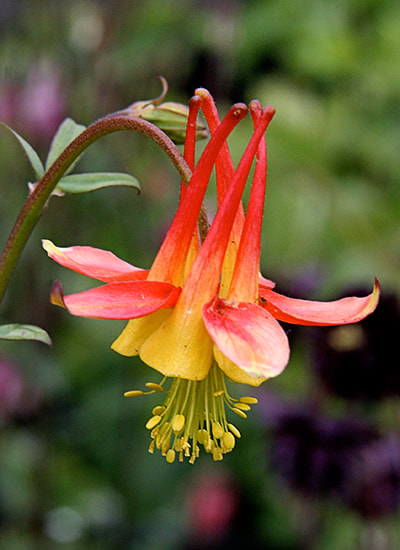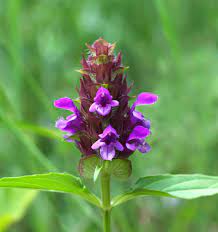Native Meadow Mix • Perennials
The Perennial seed packet is a mix of six wildflowers native to the Pacific North West. Wildflower seeds included are Biscuit Root, Blue Eyed Grass, Blanket Flower, Western Columbine, Riverbank Lupine, and Self Heal.
Sowing/Planting: The mix should be direct sowed in the fall, ideally after or just before the first good/saturating rains of the season (about mid-September, no later than late October). The seeds will lay dormant through the winter and begin to germinate in spring with its earliest blooms appearing in April and latest blooms fading in September. How and where seed mixes should be sown depends on gardening style, plant identification skills, and environmental conditions.
For those new to growing native plants from seed, and because sowing will occur several months before germination, we recommend seedbed preparations and clear marking of the planting area. To prepare a clean seed bed: prepare desired planting area, water well, wait 1-2 weeks for weeds/undesirable seed to germinate, cultivate weeds/soil, repeat at least once.
Direct sow the seed mix into these prepared beds and top with a very thin (1/4 inch) dusting of compost, or chick (not hen) grit and compost which can be bought at your local pet/feed store, hen grit is too coarse. We recommend sowing annuals and the perennial mixes together as the annuals will germinate quickly providing some winter coverage and stabilization for the soils, but recognize that this is not necessary as sowing apart will work just fine.
Alternately perennial seed can be grown in 4-inch pots in fall (3-6 seeds per pot). Make sure seeds have good contact with the potting medium and cover lightly with a dusting of compost, or a thin layer of chick grit (as mentioned above). Water plants or allow access to rain and cool temperatures (under 40 degrees), while protecting seeds/seedlings from heavy downpours, temperatures under 25-degrees, squirrels, pets, and curious children. Sowing in pots allows the grower to work on seedling identification skills and worry less about the seedlings competing against winter weeds that are lurking in garden soil, also recommended if folks cannot get a clean seed bed because they are planting in an old pasture, lawn, or weed patch. Small seedlings could either be re-potted into individual pots and nurtured in their containers until the following fall, or be planted out in February (no later than early March).
These perennials can also be potted for longer term growth in deep containers. Sow 7-10 seeds per square foot of surface area. Press down, cover with chick grit and/or a very light dusting of soil.
Please Note: Regardless of where perennial seeds are sown, they are unlikely to flower in their first year.
Water Requirements: Watering the first year of direct seeded perennial species is not needed, but will help with establishment. Transplanted perennial seedlings should be watered deeply in the summer, to reduce potential plant stress.
Please note watering after flower production can be detrimental to the plants, causing stress related issues such as mildew, root rot, or insect issues.
Wildlife: This wildflower mix should attract native pollinators, particularly solitary bees, other solitary insects, and hummingbirds.
Maintenance: These plants do not need or expect good soil. We recommend a light annual mulching (1/4 inch) around these plants when bare soil is present. Once established (year 2), the plants will still benefit from a light mulch, but their roots will not require the extra protection.
Standing stems can be left standing for habitat structure, or cut down after flowering. Seed heads can be left for birds, and/or collected to increase stock of plant material.
We do recommend identifying the Riverbank Lupine seeds/seedlings and planting them at the back or in the middle of beds as these plants can get a bit rangy. Additionally, we recommend cutting them down after flowering, or cutting the seed heads and collecting seeds as they’ve been known to shoot their seeds 2-6 feet and can get a bit aggressive in their abilities to reproduce and tolerate tough conditions. To collect seeds, snood the whole seed head after flowering (use a light mesh bag to cover seed heads, secure at stem so seed won't slip out, allow seed to naturally ripen/pop and collect seed head/bag and store in a warm, dry place for further seed cleaning). If you see predation on your seed (holes or predatory seed coat damage), throw seed heads in the freezer for 2 weeks to kill insects.
Additional Information: The biggest issue with establishment of these slow to grow seeds is unfamiliarity, leading people to accidental weeding. We recommend the Burke Herbarium and other native plant books to familiarize yourself with these plants.
There are lots of variables to plant success, patience is key. If you have additional questions or need help with plant seedling identification, please contact [email protected]
Sowing/Planting: The mix should be direct sowed in the fall, ideally after or just before the first good/saturating rains of the season (about mid-September, no later than late October). The seeds will lay dormant through the winter and begin to germinate in spring with its earliest blooms appearing in April and latest blooms fading in September. How and where seed mixes should be sown depends on gardening style, plant identification skills, and environmental conditions.
For those new to growing native plants from seed, and because sowing will occur several months before germination, we recommend seedbed preparations and clear marking of the planting area. To prepare a clean seed bed: prepare desired planting area, water well, wait 1-2 weeks for weeds/undesirable seed to germinate, cultivate weeds/soil, repeat at least once.
Direct sow the seed mix into these prepared beds and top with a very thin (1/4 inch) dusting of compost, or chick (not hen) grit and compost which can be bought at your local pet/feed store, hen grit is too coarse. We recommend sowing annuals and the perennial mixes together as the annuals will germinate quickly providing some winter coverage and stabilization for the soils, but recognize that this is not necessary as sowing apart will work just fine.
Alternately perennial seed can be grown in 4-inch pots in fall (3-6 seeds per pot). Make sure seeds have good contact with the potting medium and cover lightly with a dusting of compost, or a thin layer of chick grit (as mentioned above). Water plants or allow access to rain and cool temperatures (under 40 degrees), while protecting seeds/seedlings from heavy downpours, temperatures under 25-degrees, squirrels, pets, and curious children. Sowing in pots allows the grower to work on seedling identification skills and worry less about the seedlings competing against winter weeds that are lurking in garden soil, also recommended if folks cannot get a clean seed bed because they are planting in an old pasture, lawn, or weed patch. Small seedlings could either be re-potted into individual pots and nurtured in their containers until the following fall, or be planted out in February (no later than early March).
These perennials can also be potted for longer term growth in deep containers. Sow 7-10 seeds per square foot of surface area. Press down, cover with chick grit and/or a very light dusting of soil.
Please Note: Regardless of where perennial seeds are sown, they are unlikely to flower in their first year.
Water Requirements: Watering the first year of direct seeded perennial species is not needed, but will help with establishment. Transplanted perennial seedlings should be watered deeply in the summer, to reduce potential plant stress.
Please note watering after flower production can be detrimental to the plants, causing stress related issues such as mildew, root rot, or insect issues.
Wildlife: This wildflower mix should attract native pollinators, particularly solitary bees, other solitary insects, and hummingbirds.
Maintenance: These plants do not need or expect good soil. We recommend a light annual mulching (1/4 inch) around these plants when bare soil is present. Once established (year 2), the plants will still benefit from a light mulch, but their roots will not require the extra protection.
Standing stems can be left standing for habitat structure, or cut down after flowering. Seed heads can be left for birds, and/or collected to increase stock of plant material.
We do recommend identifying the Riverbank Lupine seeds/seedlings and planting them at the back or in the middle of beds as these plants can get a bit rangy. Additionally, we recommend cutting them down after flowering, or cutting the seed heads and collecting seeds as they’ve been known to shoot their seeds 2-6 feet and can get a bit aggressive in their abilities to reproduce and tolerate tough conditions. To collect seeds, snood the whole seed head after flowering (use a light mesh bag to cover seed heads, secure at stem so seed won't slip out, allow seed to naturally ripen/pop and collect seed head/bag and store in a warm, dry place for further seed cleaning). If you see predation on your seed (holes or predatory seed coat damage), throw seed heads in the freezer for 2 weeks to kill insects.
Additional Information: The biggest issue with establishment of these slow to grow seeds is unfamiliarity, leading people to accidental weeding. We recommend the Burke Herbarium and other native plant books to familiarize yourself with these plants.
There are lots of variables to plant success, patience is key. If you have additional questions or need help with plant seedling identification, please contact [email protected]






